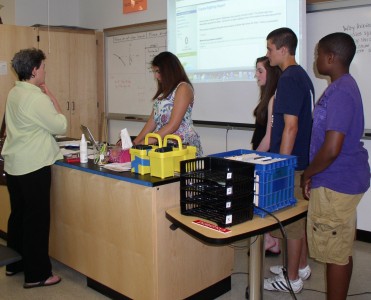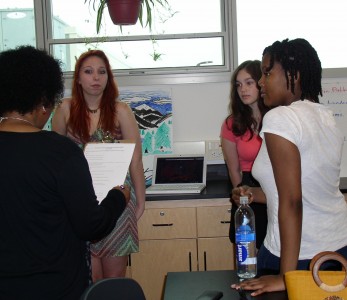By Casey Hans
AAPSNews Service
Teacher David Coupland offered his ninth-grade biology students at Skyline High School a unique opportunity this spring involving a topic much on the minds of area residents: The apparent prevalence of coyotes in populated areas such as Ann Arbor.
Two teams took the challenge: Michael Rochell, Joel Frison, Shannon Cowley and Zena Shunnar did a web-based survey of the community about coyote sightings and analyzed the data and Alexandra Lund, Danielle Sarns and Jeremy Glick studied the evolution of the coyote.

All presented their findings at Skyline’s first Conference on Evolution of Michigan Wildlife as part of the ninth-grade ACIS I Biology classes. Their findings can also be found online at the Google Site page: https://sites.google.com/site/washtenawcoyote/home and include their survey analysis and a Google Earth map plotting the sightings.
Of the more than 200 residents responding to the survey, most said they had seen no direct effects from coyotes, though many said they wouldn’t let their children walk their dogs or let their cats out to roam at night. “They’ve been able to coexist well with humans,” noted Rochell, who plotted the coyote sightings on the Google Earth map. “A lot of people said they’re alright (with the coyotes) as long as they’re not hurting me,” added Shunnar. A total of 14 of those responding said they had lost a pet to a coyote.
The evolution project is a joint effort between Skyline and the University of Michigan Exhibit Museum of Natural History and is led by Skyline teacher Johnna Coleman with support from Kira Berman, education director at the U-M Exhibit Museum. Groups of three to four students chose an animal to research and produced an online interactive poster called a “glog” (www.glogster.com), presenting their projects to a group of parent judges on June 9.

The glogs selected to be among the best will be linked to the Exhibit Museum website.
Coleman said the project was designed to make learning more authentic for students, especially involving the collaboration with U-M. “We’re trying to get them to be more analytical,” she added.
A total of 425 ninth-graders took part, studying a variety of species including the least weasel.
Jonathan Shiplett, Hannah Gauss and Savannah Middleton were on a least weasel study team. Their study history of the species covered four continents and a timeline over 7 million years. “Due to forests disappearing, it reduced in size … to allow it to get into the holes of rodents,” Shiplett explained. He said he was most impressed with the least weasel being able to take down much larger animals five to 10 times its size.
Parent Kathy Shay served as one of the 50 judges for the June 9 Conference on Evolution of Michigan Wildlife at Skyline. She said she was impressed with the students’ work, but noted that some were better prepared than others; some communicated well, shook hands and introduced themselves, she said.
“I think it’s really positive,” she said. “It’s an opportunity to learn to communicate about what they’re learning. I think it’s a great idea and I really like being invited.”
Coupland said he was impressed with all of the student work, but that the coyote project broke some scientific ground. “As far as know, this data’s never been collected,” he said. “They did some science that’s not been done before.”
Freshman Joel Frison said the group stepped up for the coyote project because they thought it would be fun to work together. “It’s a big topic and a lot of people have been talking about it lately,” he said. “It was a lot of hard work, but it was definitely worth it.”

